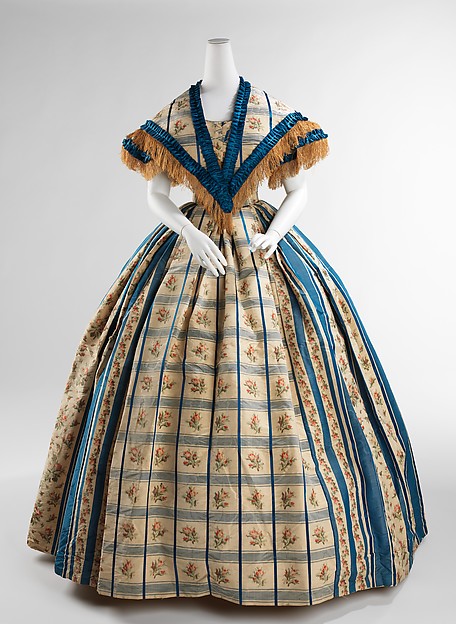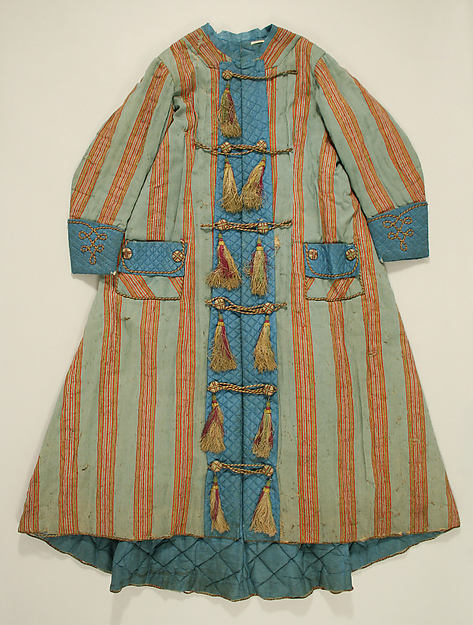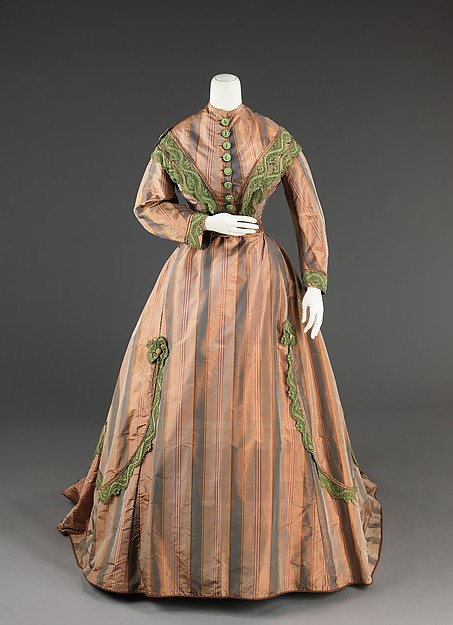 |
| Silk dress, c. 1865 |
An 1861 Peterson's article on "The Use and Abuse of Color in Dress" offers advice for 'harmonizing' colors to one's complexion. Some of the fashionable colors mentioned include "mauve" and "magenta", and readers are advised to use the later sparingly, ideally paired with white or black. Purples, similarly, should be shaded to one's tones, and can be paired with greens to avoid making the skin look yellow. Scientific American (!!!) ran a similar article in 1863. Color in Dress: A Manual for Ladies (1870) develops these ideas further, recommending particular colors for different hair/skin tones, as well as the accent colors with which to pair them. Fair blonds, for instance, may wear light blue bonnets trimmed with white, black, or small amounts of yellow, orange, straw-color, or stone-color (but not purple or pink!).
"How to Choose Colors in Dress" (Peterson's, 1855, starts page 138) discusses how colors look in combination, and how they interact with one's complexion; this is re-visted in the 1858 Peterson's article "Colors in Dress" (page 252), with more attention given to coordinating colors with the hair. An 1855 article in Harper's (page 814) gets into more detail about which colors go well with which skin tones, assuming everyone to either be a dark brunette or a fair blonde. There's this shorter article from 1860 on trim colors and complexion, if anyone's inclined to upholster their coach in a flattering tone.
Our Deportment (1880) is after our period of interest, but includes a thorough list of color pairings (pages 338-343) which, as far as I've been able to tell, correspond fairly well to the tastes of 15-20 years earlier. To give an example, lilac is said to harmonize poorly with white or grey, but its recommended accompaniments include:
lilac and maize
lilac and cherry
lilac and gold or gold-color
lilac and scarlet
lilac and crimson
lilac, scarlet and white or black
lilac, gold color and crimson
lilac, yellow or gold, scarlet and white
Some of the observations, including pink and blue being a weak combination, are echoed in the earlier sources. Others, such as blue being paired with maize or straw color, and with orange (though without the recommended white/black addition), show up in garments of the 1860s:
 |
| Evening dress, c. 1857-60 |
 |
| Dressing Gown, 1860 |
I've found no comparable color list from the early '60s, but skimming the colored fashion plate descriptions from Godey's gives a few ideas:
1861: Black with jet; black and gold headdress
Pink and white; gold headdress
Purple and black; white with black and 'straw-color'
Fawn-colored; white bonnet
Light green dress; white with back lace and poppies
Dove-colored and crimson; black straw with black and lemon
'Stone-color' and black; straw with poppy-colored and black
Purple and black; straw with purple
Magenta and black trim (on a dress, main color not given)
Mauve trimmed with a darker shade; white with black lace
Green and white; headdress of gold and pink roses
Gray silk with black
Gray and blue cashmere, with blue silk
Pink and white; white straw trimmed pink
Apple green skirt with a white waist, black velvet trim
Light grey silk with brown spots, trimmed brown; black and white bonnet
Purple with imitation fur, white lining; white and purple cap
Forest green dress; riding hat with brown veil
1863: Blue dress; black opera cloak with gold embroidery; headdress of black lace, roses, and coral
Pink and black skirt, white bodice, black velvet trimmings
Lilac dress "trimmed with a darker shade"; white and black shawl
White dress trimmed pink; black and pink headdress
White with pale blue trim and black lace
White dress with green leaves; green and pink headdress
Apple green dress with chenille embroidery (no color given)
Mauve with black lace; white bonnet with mauve trim
Black dress with violet-colored vest
White dress; green sash and headdress
Blue dress trimmed white and black; headdress of white feathers and wheat ears
Grey foulard (type of pattern/print) silk dress with blue velvet trim
Fawn-colored with green
1865: White silk with crimson velvet; crimson headdress
Lemon-colored silk with white lace
Pearl-grey silk "spotted green" with green trim
Blue and white striped silk with blue trim and white lace
Dove-colored silk with black velvet
Blue trimmed with black velvet
Green poplin trimmed with green velvet
Maize-colored poplin with black
Grey poplin with black and jet
White muslin with pink silk
Light green and black silk, darker green trim
Fawn-color trimmed blue
White with scarlet
Grey with black and crimson
Maize with brown
Mauve with white
Lavender with green and white
Grey with silver buttons
(If the above was unclear, the dress or ensemble is listed first, starting with the ground or dominant color; the headdress or bonnet colors follow the semicolon).
 |
| Silk dress c. 1865 On my monitor, this reads as a orangey-salmon and black striped dress with green trim. On Deportment calls black and orange a "rich harmony", and also recommends pairing orange with green. |
No comments:
Post a Comment